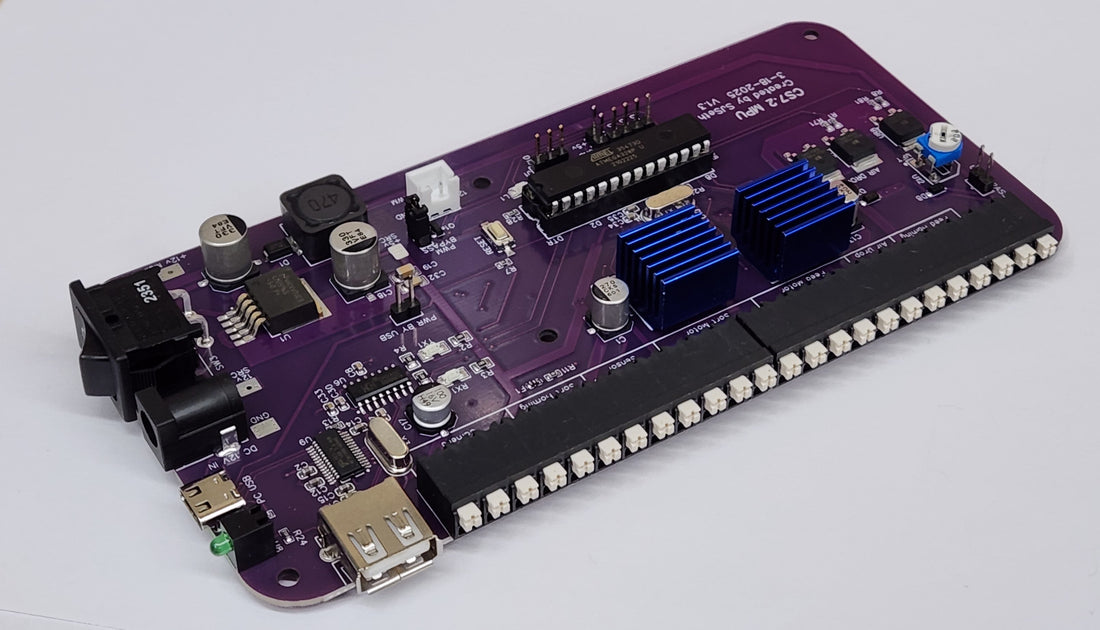
CS7.2 Release Updates
Share
I have been lagging on getting this information out in whole and it has been surfacing bit by bit on the different Discord channels, but wanted to create this blog to add information and progress updates for the CS7.2 Release.
What is CS7.2?
CS7.2 is a refinement on CS7.1 and designed to make the project easier for new and first time builders. If you already have a CS7.1 build, there is little benefit to upgrading unless you see something in the CS7.2 build that you like.
What changed since CS7.1?
The biggest difference in CS7.2 is that is uses a new electronics package which is a single integrated PCB designed by me. Why? I am glad you asked! As the community has been supporting new builders, it has been clear to me that there are a few issues that come up time and time again and almost always center around the electronics package. Faulty shields, faulty Arduinos, bad wiring, bad pins, bent pins, backwards motor controller, etc. I believe this new board solves those problems. The wiring strategy for the new board is to use ferrule connectors which are widely available and super easy to use (as opposed to the dupont connectors). The new board has spring terminal clamps so you can just push the ferrule into the board to connect and to release, push the white button and pull the ferrule/wire out.
Design Changes: In addition to the electronics, there have been a few design changes.
On the classifier base, we are using optical homing sensors. to facilitate this and better wire routing, the classifier base has been modified slightly.

The tension cam and cam stop have been redesigned and the new design is easier to work with while providing more consistent tension and angle management. The CS7.2 Repo is standardized on @shibby's feed wheels which have labeled wheels and tighter bearing seats. This has been a great contribution and I really appreciate the work @shibby has done there.
The proximity sensor type has changed. Previously we were using the NPN NO proximity sensor and I have switched it to a PNO NO sensor. This has been a source of confusion in the past and it was time to finally eliminate that. The proximity sensor runs on 12v from the board and the board has a custom voltage divider to make the signal safe for the MPU. This provides optimal detection while protecting the electronic components.
On the sorter, a new sorter bracket/base has been created which integrates the optical homing switch. In addition a new sorter pipe bracket and pipe set has been created leveraging the hex pipe design. The sorter bracket now has a movable homing ring which can be used to manually adjust "slot zero" on the sorter to any position desired. The hex pipe design is printed on its side which helps to align the 3d print lines with the movement of brass. In addition, the bracket and pipes have index dents so that the pipe can be accurately snapped in place giving a true vertical
We have retired the 8 slot guide as well. There are now index lines on the sorter base which you can use to align your buckets. Over the year or 2 one of the common problems was that brass would either get stuck in between the base and the guides or cause a jam if it didn't clear the pipe in time. This eliminates that issue. The new base also integrates well with the new pipe mounting brackets so that the wiring can be concealed within the dedicated wire channels.
A New Camera Design fixes another pain point which has been the difference in image quality between v1 and v2 camera. Going forward we will only be using the V2 camera module. The camera housing has been redesigned as well to use a clamshell design which makes assembling it much easier. In addition a new backlighting strategy is in place which leverages a custom light ring and diffuser. The end result here should be more consistency between builds which ultimately should make model sharing a more viable option.